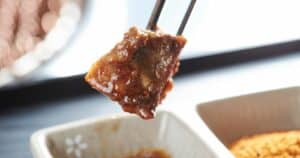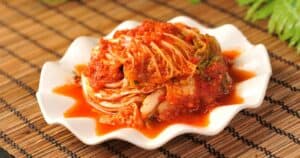Are you a fan of Korean cuisine but concerned about its sodium content? You’re not alone! Many people wonder if Korean food is traditionally high in sodium and how it may impact their health.
In this blog post, we’ll dive into the facts surrounding this topic and explore ways to enjoy Korean food while managing your sodium intake.
Yes, Korean food can indeed be high in sodium. A range of dishes, such as kimchi, salted seafood, ramen, soups, and stews, contain substantial amounts of sodium. The consumption of kimchi, in particular, plays a significant role in the Korean diet’s sodium levels.
Excessive sodium intake has been linked to hypertension and diabetes cases in South Korea. However, it’s essential to note that not all Korean dishes are high in sodium, and there are ways to make healthier choices.
To enjoy Korean food without consuming excessive sodium, you can opt for dishes that are not pickled or fermented. Grilled meats and stir-fried vegetables are great alternatives. When ordering food, you can also request less salt or soy sauce.
If you enjoy cooking, preparing Korean food at home allows you to control the sodium content by using low-sodium ingredients. With these strategies, you can still savor the flavors of Korean cuisine while managing your sodium intake effectively.
The Impact of High Sodium Intake on Health
High sodium intake can have a significant impact on health. Excessive salt intake is associated with high blood pressure, which is a major risk factor for cardiovascular diseases. It is also linked to other health conditions such as stomach cancer, obesity, metabolic syndrome, autoimmunity, kidney stones, and osteoporosis.
Consuming too much sodium can cause target organ damage and have direct effects on the brain, heart, kidneys, and vasculature. It can lead to high blood pressure, heart disease, and stroke. Additionally, high sodium intake can cause calcium losses, contributing to bone health issues.
Reducing sodium intake is crucial for maintaining a healthy blood pressure and overall health. Sodium intake from processed and restaurant foods is a significant contributor to high blood pressure, heart attack, and stroke.
By being mindful of sodium intake and aiming for a balanced diet that includes moderate sodium consumption, it is possible to prevent high blood pressure-related deaths and save healthcare costs. Lowering sodium intake is recommended to avoid long-term health issues such as enlarged heart muscle, headaches, heart failure, kidney disease, kidney stones, osteoporosis, stomach cancer, and stroke.
To minimize high sodium intake, it is important to make conscious food choices. One significant area to focus on is Korean cuisine, which has gained popularity worldwide. While Korean food offers a variety of flavors and dishes, it is important to be aware that some Korean dishes can be high in sodium.
For example, traditional dishes like kimchi, doenjang-jjigae (soybean paste stew), and samgyeopsal (grilled pork belly) may contain high levels of sodium due to the use of soy sauce, fermented ingredients, and cured meats.
To reduce sodium intake when enjoying Korean food, here are some tips:
- Choose grilled or steamed dishes over fried ones. Grilled meats, seafood, and vegetables are usually lower in sodium compared to deep-fried options like tempura or fried chicken.
- Opt for fresh side dishes like fresh vegetables, sprouts, or steamed tofu instead of heavily seasoned and fermented options like kimchi or pickled vegetables.
- Control the amount of soy sauce or other condiments added to your dishes. These condiments can be high in sodium, so use them in moderation or ask for them on the side to control your intake.
- Pay attention to the sodium content of pre-packaged Korean food products, like instant noodles or ready-to-eat soups. They may contain high levels of sodium, so it is important to read food labels and choose lower sodium options.
The Role of Kimchi in Korean Cuisine
Kimchi is a traditional fermented vegetable dish from Korea, and it plays a vital role in Korean cuisine. Here’s why:
Essential Staple: Kimchi is a staple food in Korean cuisine and is served as a side dish with almost every Korean meal. It adds a unique flavor and texture to the overall dining experience.
Versatility: Kimchi is incredibly versatile and can be used in various dishes. It is not only enjoyed as a side dish but also forms a key ingredient in many Korean soups and stews, adding depth and tanginess to the flavors.
Cultural Identity: Kimchi is deeply ingrained in Korean culture and is considered a symbol of Korean identity and pride. With countless regional and household variations, it reflects the diversity and rich culinary heritage of Korea.
Nutritional Benefits: Apart from its delicious taste, kimchi is also packed with nutrients and antioxidants. It is known to improve digestion, boost the immune system, and reduce inflammation, making it a healthy addition to the Korean diet.
Sodium Content in Traditional Korean Dishes
Traditional Korean dishes can often have high sodium content due to the use of fermented foods and condiments. Kimchi, a staple in Korean cuisine, is a major contributor to sodium intake. Fermented foods such as soybean pastes and pickled vegetables also contain significant amounts of sodium.
The average sodium intake of Koreans is reported to be one of the highest in the world. However, the Korean government has recognized the issue and taken steps to reduce salt in traditional foods.
Fermented foods such as soybean pastes and pickled vegetables can contain high levels of sodium. The sodium content in these foods can range from 488 mg to 5640 mg per 100 grams. Kimchi, which is made from fermented vegetables, is a major source of sodium in Korean cuisine. On average, kimchi contributes to 19.6% of sodium intake in Korea. A cup of kimchi, weighing around 150 grams, typically contains approximately 747 mg of sodium.
The average sodium intake of Koreans is reported to be 5,279.9 mg per day, which is considered high compared to other countries. This high sodium intake has been attributed to the consumption of various Korean dishes that are rich in sodium. In addition to kimchi, other sources of dietary sodium in Korean cuisine include soy sauce, soybean paste, hot pepper paste, and salted fish.
Recognizing the issue of high sodium intake, the Korean government has taken steps to reduce salt in traditional foods, including kimchi. By reducing the sodium content in these dishes, they aim to promote healthier eating habits among the population. This highlights the importance of being mindful of sodium intake and opting for a balanced diet that includes moderate sodium consumption.
Managing Sodium Intake When Eating Out
Eating out can pose challenges for managing sodium intake, as many restaurant dishes are high in sodium. However, there are strategies you can employ to reduce your sodium consumption and make healthier choices. Here are some tips to help you manage your sodium intake when dining out:
Do your prep work: Before going to a restaurant, research the menu online. Look for dishes that are lower in sodium or ask if the restaurant can accommodate your request for a lower sodium meal. This can help you make more informed choices and reduce your sodium intake.
Ask for nutrition information: Some restaurants provide nutrition information upon request. By asking for this information, you can effectively assess the sodium content in different dishes. This will enable you to choose options that are lower in sodium and align with your dietary needs.
Request no salt: When placing your order, ask the restaurant staff to exclude added salt from your meal. This simple request can help significantly reduce the overall sodium content of your dish.
Choose fresh options: Opt for fresh fruits, vegetables, and salads as side dishes or main courses. These naturally low-sodium options can help balance out your meal and contribute to a healthier overall sodium intake.
Avoid processed and fried foods: Processed and fried foods tend to be higher in sodium. Instead, opt for grilled, baked, or roasted options. These cooking methods can help minimize sodium content while still providing flavorful and satisfying meals.
Be mindful of sauces and condiments: Sauces and condiments often contain high amounts of sodium. Ask for them to be served on the side so you can control the amount you use. Alternatively, choose low-sodium or salt-free options whenever possible.
Share or take half home: Restaurant portions are often larger than necessary. Consider sharing a dish with a friend or taking half of it home. This not only reduces your sodium intake but also allows you to enjoy the meal over multiple sittings.
Season with alternatives: Instead of relying on salt, use herbs, spices, garlic, citrus juice, or salt-free seasonings to add flavor to your meal. These alternatives can enhance the taste without adding unnecessary sodium.
Sodium Reduction Strategies for Korean Cooking at Home
Korean cuisine is known for its bold and flavorful dishes, but many traditional recipes tend to be high in sodium. However, there are several strategies you can implement to reduce the sodium content of your favorite Korean dishes without compromising on taste. Here are some effective sodium reduction strategies for Korean cooking at home:
Use less salt and soy sauce: One of the simplest ways to cut down on sodium is to decrease the amount of salt or soy sauce you use when preparing Korean dishes. Start by gradually reducing the quantity of these seasonings and experiment with alternative flavor enhancers such as herbs, spices, garlic, and citrus juice.
Opt for fresh ingredients: Fresh ingredients like fruits, vegetables, and meats are naturally lower in sodium compared to processed or canned foods. When cooking Korean dishes, prioritize fresh produce and meats to keep your sodium intake in check. This will not only reduce sodium but also provide more nutrients to your meals.
Rinse and soak high-sodium ingredients: Certain Korean ingredients like kimchi, soybean paste, and salted fish are inherently high in sodium. However, you can reduce their sodium content by rinsing or soaking them before using. This process helps to remove excess salt and lower the overall sodium levels in your dishes.
Make your own broth: Store-bought broths often contain high amounts of sodium. To control the sodium content of your Korean dishes, consider making your own broth at home. Simmer bones, vegetables, and herbs in water to create a flavorful, low-sodium broth that can be used as a base in various recipes.
Choose low-sodium ingredients: Look for low-sodium versions of staple Korean ingredients like soy sauce, miso paste, and canned beans. These alternatives are specifically designed to have reduced sodium levels while still providing the desired flavors to your dishes.
Incorporate potassium-rich ingredients: High-potassium foods, such as fish, potatoes, and soy, can help balance out your sodium intake. Include these ingredients in your Korean dishes to enhance flavor while reducing the negative effects of sodium on your health.
Monitor portion sizes: Being mindful of portion sizes is crucial for managing sodium intake. Overeating can lead to consuming higher amounts of sodium even if you have implemented other sodium reduction strategies. Be aware of your serving sizes and avoid excessive intake of salty Korean dishes.
By adopting these sodium reduction strategies, you can enjoy the flavors of traditional Korean cuisine while significantly reducing your sodium intake. Embracing fresh ingredients, experimenting with alternative seasonings, and considering homemade alternatives will make your Korean cooking healthier and more flavorful for you and your loved ones.
Simple and Low-Sodium Korean Recipes
- Kimchi Stew: A classic Korean dish, kimchi stew can be made with low-sodium broth and less salt. Sauté garlic and onions in oil, then add chopped kimchi, broth, and tofu. Simmer until tofu is cooked through and serve with rice.
- Braised Tofu: This flavorful and low-sodium dish can be served as a main or side. Sauté garlic and onions in oil, then add cubed tofu, soy sauce, and water. Simmer until tofu is cooked through and the sauce has thickened. Enjoy with rice.
- Japchae: Korean sweet potato noodles are the star of this dish, made with low-sodium soy sauce and less salt. Cook the noodles according to package instructions, then sauté vegetables like spinach, carrots, and mushrooms in oil. Add the cooked noodles and soy sauce, tossing until well combined. Serve hot or cold.





